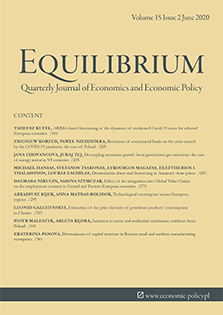Estimation of the price elasticity of petroleum products’ consumption in Ukraine
Estimation of the price elasticity of petroleum products’ consumption in Ukraine
Author(s): Leonid GalchynskyiSubject(s): Energy and Environmental Studies, Present Times (2010 - today), Financial Markets
Published by: Instytut Badań Gospodarczych
Keywords: petroleum product market; elasticity; volatility; model; co-integration;
Summary/Abstract: Research background: The analysts of the petroleum product markets of industrial countries believe that the elasticity of demand varies at different periods, which gave rise to the hypothesis that behavioral and structural factors have changed the consumers’ reaction during the last few decades, with a change in prices of petroleum products. Purpose of the article: The purpose of this article is to study the elasticity of demand and prices in order to identify changes in consumer behavior in the oil market after significant socioeconomic shocks and to establish a correlation between changes in elasticity and price volatility, with the Ukrainian petroleum products market as an illustrative example. Methods: Based on the time series of the petroleum product market of Ukraine, static and dynamic models for assessing the demand elasticity were constructed. It was found that the time series of demand for petroleum products is non-stationary but then the time series of the first differences is stationary according to the extended Dickey-Fuller test; further, the fact of cointegration between time series of consumption, income, and prices was established by the Johansson test. This made it possible to construct co-integration dependence, allowing, in turn, the development of models for assessing the elasticity of demand for petroleum products, on the basis of which objective assessments of changes in consumer behavior were established. Analysis of the monthly calculation of petroleum products’ price volatility during the period 2008 to 2018 has showed that the values of volatility increased abnormally in the period between the beginning of 2014 and the middle of 2015. The estimates of price and demand elasticities obtained for the two periods up to the beginning of 2014 and the second half of 2015 differ significantly from the values of the corresponding elasticities between the beginning of 2014 and the middle of 2015. Findings & Value added: Assessments of income elasticities and price elasticities for petroleum products in the Ukrainian market were obtained by three co-integration models, both short and long term, for each of the three previously defined time intervals. In one of them, characterized by a high level of price volatility conditionally referred to as a crisis, the value of elasticities differed markedly from the corresponding values in the other two periods, in particular, -0.383 for price elasticity and 1.068 for a long-term bond. In the other two periods, these were, respectively, 0.543 for price elasticity and 0.274 for long-term pre-crisis elasticity, and -0.470 for price elasticity and 0.235 for long-term post-crisis elasticity. Appropriate elasticity estimates were obtained for both the short-run and the dynamic model, for the same defined intervals. A comparison of these estimates showed the closeness of the values of elasticities for the pre-crisis and post-crisis intervals and a marked difference from the estimates of the elasticities in the crisis interval. Thus, it was found that a significant change in elasticities is accompanied by an increase in price volatility.
Journal: Equilibrium. Quarterly Journal of Economics and Economic Policy
- Issue Year: 15/2020
- Issue No: 2
- Page Range: 315-339
- Page Count: 25
- Language: English

